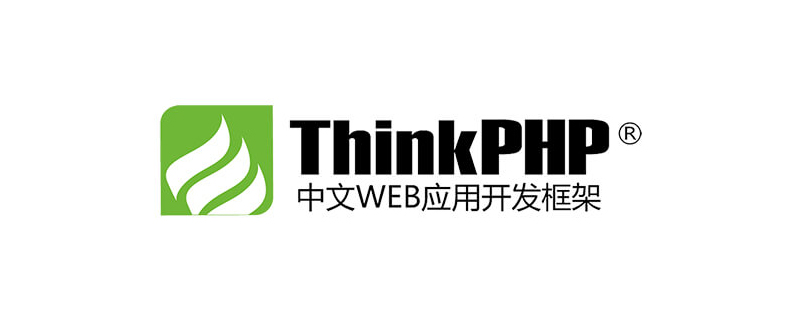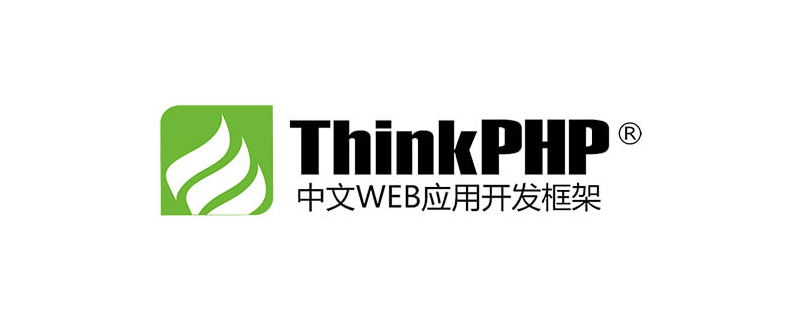With the continuous development of the Internet, more and more websites have emerged, but at the same time, website security problems have become more and more serious. Security vulnerabilities such as hacker attacks, malware, and SQL injection cause headaches for website operators. In order to ensure the security of the website, security testing during website construction and operation is also particularly important. This article will introduce how to use ThinkPHP6 to implement website security detection and help website operators further improve website security.
1. What is ThinkPHP6
ThinkPHP6 is a PHP development framework and the latest version of the ThinkPHP series. This framework has the characteristics of high performance, efficiency, simplicity and ease of use, and rapid development, and is widely used in the rapid development of Web applications. At the same time, ThinkPHP6 also provides a variety of security mechanisms, such as data filtering, CSRF filtering, XSS injection filtering, etc., to help users better protect website security.
2. Basic knowledge of security detection
Before implementing security detection, you need to master some basic knowledge. The purpose of security detection is to discover and repair potential vulnerabilities on the website, so a good security detection plan must meet the following aspects:
1. Conduct a comprehensive detection of the website, including website structure, code, and database , applications, etc.
2. Detect common attack methods, such as SQL injection, XSS injection, CSRF, etc.
3. Carry out targeted detection based on the different complexity of each function of the website.
4. Provide a detailed detection report and provide corresponding repair suggestions.
3. Security mechanism of ThinkPHP6
ThinkPHP6 provides a variety of mechanisms to enhance the security of the website.
1. Data filtering
Data filtering refers to verifying and filtering data submitted by users to prevent malicious attacks. In ThinkPHP6, data filtering is divided into two steps: verification and filtering. Verification refers to determining whether the data submitted by the user conforms to the specified format and requirements, while filtering refers to converting or replacing dangerous characters.
2.CSRF filtering
Cross-site request forgery (CSRF) is a common attack method. The attacker pretends to be a user and sends a request to the server without the user's knowledge. Modify user data. To prevent such attacks, ThinkPHP6 provides a CSRF filtering mechanism to ensure the security of the website by generating a random Token string.
3.XSS injection filtering
Cross-site scripting (XSS) refers to an attacker inserting malicious script code into a website to obtain user information. ThinkPHP6 provides an XSS injection filtering mechanism to prevent websites from being attacked by malicious XSS.
4. Use ThinkPHP6 to implement website security detection
Before using ThinkPHP6 to implement security detection, you need to install the ThinkPHP6 environment and create a good website. Here are some commonly used security detection tools.
- SQLMAP
SQLMAP is a powerful SQL injection tool that can be used to detect SQL injection vulnerabilities in websites. It can discover and exploit SQL injection vulnerabilities to obtain sensitive information in the database. In order to use SQLMAP, you need to enter the corresponding command on the command line.
- W3af
W3af is a framework for web application security testing. It can automatically discover common web application vulnerabilities, such as SQL injection and XSS injection. , CSRF, etc. W3af is easy to use and flexible, supporting a variety of plug-ins and extensions.
- DirBuster
DirBuster is a tool used to discover hidden pages in websites. It can detect security vulnerabilities such as website blasting, directory traversal, and external files. DirBuster automatically scans the files and directories of the website, and also provides user-defined dictionary functions and supports multi-threaded scanning, which can greatly improve the scanning speed.
4. Summary
This article introduces how to use ThinkPHP6 to implement website security detection. With the development of the Internet, ensuring website security has become a very important task in the process of website construction and operation. By using the security mechanisms and common security detection tools provided by ThinkPHP6, potential security vulnerabilities of the website can be effectively discovered and repaired, helping the website to better protect user information and maintain security.
The above is the detailed content of Using ThinkPHP6 to implement website security detection. For more information, please follow other related articles on the PHP Chinese website!
 i7-7700无法升级至Windows 11的解决方案Dec 26, 2023 pm 06:52 PM
i7-7700无法升级至Windows 11的解决方案Dec 26, 2023 pm 06:52 PMi77700的性能运行win11完全足够,但是用户却发现自己的i77700不能升级win11,这主要是受到了微软硬性条件的限制,所以只要跳过该限制就能安装了。i77700不能升级win11:1、因为微软限制了cpu的版本。2、intel只有第八代及以上版本可以直升win11。3、而i77700作为7代,无法满足win11的升级需求。4、但是i77700在性能上是完全能流畅使用win11的。5、所以大家可以使用本站的win11直装系统。6、下载完成后,右键“装载”该文件。7、再双击运行其中的“一键
 摔倒检测,基于骨骼点人体动作识别,部分代码用 Chatgpt 完成Apr 12, 2023 am 08:19 AM
摔倒检测,基于骨骼点人体动作识别,部分代码用 Chatgpt 完成Apr 12, 2023 am 08:19 AM哈喽,大家好。今天给大家分享一个摔倒检测项目,准确地说是基于骨骼点的人体动作识别。大概分为三个步骤识别人体识别人体骨骼点动作分类项目源码已经打包好了,获取方式见文末。0. chatgpt首先,我们需要获取监控的视频流。这段代码比较固定,我们可以直接让chatgpt完成chatgpt写的这段代码是没有问题的,可以直接使用。但后面涉及到业务型任务,比如:用mediapipe识别人体骨骼点,chatgpt给出的代码是不对的。我觉得chatgpt可以作为一个工具箱,能独立于业务逻辑,都可以试着交给c
 一起聊聊thinkphp6使用think-queue实现普通队列和延迟队列Apr 20, 2022 pm 01:07 PM
一起聊聊thinkphp6使用think-queue实现普通队列和延迟队列Apr 20, 2022 pm 01:07 PM本篇文章给大家带来了关于thinkphp的相关知识,其中主要介绍了关于使用think-queue来实现普通队列和延迟队列的相关内容,think-queue是thinkphp官方提供的一个消息队列服务,下面一起来看一下,希望对大家有帮助。
 MIT最新力作:用GPT-3.5解决时间序列异常检测问题Jun 08, 2024 pm 06:09 PM
MIT最新力作:用GPT-3.5解决时间序列异常检测问题Jun 08, 2024 pm 06:09 PM今天给大家介绍一篇MIT上周发表的文章,使用GPT-3.5-turbo解决时间序列异常检测问题,初步验证了LLM在时间序列异常检测中的有效性。整个过程没有进行finetune,直接使用GPT-3.5-turbo进行异常检测,文中的核心是如何将时间序列转换成GPT-3.5-turbo可识别的输入,以及如何设计prompt或者pipeline让LLM解决异常检测任务。下面给大家详细介绍一下这篇工作。图片论文标题:Largelanguagemodelscanbezero-shotanomalydete
 改进的检测算法:用于高分辨率光学遥感图像目标检测Jun 06, 2024 pm 12:33 PM
改进的检测算法:用于高分辨率光学遥感图像目标检测Jun 06, 2024 pm 12:33 PM01前景概要目前,难以在检测效率和检测结果之间取得适当的平衡。我们就研究出了一种用于高分辨率光学遥感图像中目标检测的增强YOLOv5算法,利用多层特征金字塔、多检测头策略和混合注意力模块来提高光学遥感图像的目标检测网络的效果。根据SIMD数据集,新算法的mAP比YOLOv5好2.2%,比YOLOX好8.48%,在检测结果和速度之间实现了更好的平衡。02背景&动机随着远感技术的快速发展,高分辨率光学远感图像已被用于描述地球表面的许多物体,包括飞机、汽车、建筑物等。目标检测在远感图像的解释中
 AAAI2024:Far3D - 创新的直接干到150m视觉3D目标检测思路Dec 15, 2023 pm 01:54 PM
AAAI2024:Far3D - 创新的直接干到150m视觉3D目标检测思路Dec 15, 2023 pm 01:54 PM最近在Arxiv上阅读到一篇关于纯视觉环视感知的最新研究,该研究基于PETR系列方法,并专注于解决远距离目标检测的纯视觉感知问题,将感知范围扩大到150米。这篇论文的方法和结果对我们来说有很大的参考价值,所以我尝试着对其进行解读原标题:Far3D:ExpandingtheHorizonforSurround-view3DObjectDetection论文链接:https://arxiv.org/abs/2308.09616作者单位:北京理工大学&旷视科技任务背景三维物体检测在理解自动驾驶
 thinkphp3.2怎么关闭调试模式Apr 25, 2022 am 10:13 AM
thinkphp3.2怎么关闭调试模式Apr 25, 2022 am 10:13 AM在thinkphp3.2中,可以利用define关闭调试模式,该标签用于变量和常量的定义,将入口文件中定义调试模式设为FALSE即可,语法为“define('APP_DEBUG', false);”;开启调试模式将参数值设置为true即可。
 thinkphp6教程笔记(总结分享)May 06, 2022 pm 12:12 PM
thinkphp6教程笔记(总结分享)May 06, 2022 pm 12:12 PM本篇文章给大家带来了关于thinkphp的相关知识,其中主要总结了一些笔记知识点,包括了模型、系统服务、laket-admin项目等内容,下面一起来看一下,希望对大家有帮助。


Hot AI Tools

Undresser.AI Undress
AI-powered app for creating realistic nude photos

AI Clothes Remover
Online AI tool for removing clothes from photos.

Undress AI Tool
Undress images for free

Clothoff.io
AI clothes remover

AI Hentai Generator
Generate AI Hentai for free.

Hot Article

Hot Tools

EditPlus Chinese cracked version
Small size, syntax highlighting, does not support code prompt function

ZendStudio 13.5.1 Mac
Powerful PHP integrated development environment

VSCode Windows 64-bit Download
A free and powerful IDE editor launched by Microsoft

SublimeText3 Mac version
God-level code editing software (SublimeText3)

Dreamweaver Mac version
Visual web development tools





